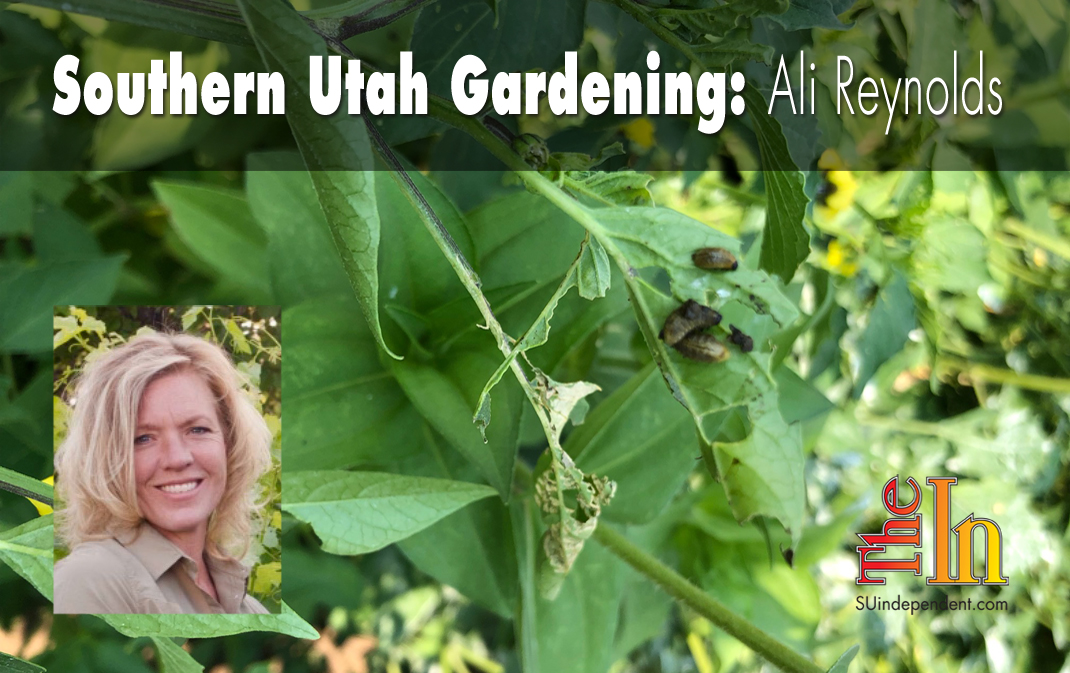
Southern Utah Gardening: How to control Colorado potato beetles
The pretty yellow-and-black-striped Colorado potato beetle is native to wild solanaceous plants of the semi-arid western United States. Our problem with it began when the beetle broadened its interest to include cultivated plants in the same family, such as potato, eggplant, tomatillo, and tomato. In my garden, it seems that they love tomatillos the best. One day, every thing looks great, and the next, you see your tomatillo plant has been taken over and almost destroyed. In this article, I’ll show you how to control Colorado potato beetles.
The Colorado potato beetle has become resistant to a large number of conventional pesticides. As a kitchen gardener, you can choose from physical, horticultural, or biological controls. Most likely, a mix of strategies will be your best policy.
First, there’s rotation, the old standby. In spring, adult Colorado potato beetles emerge from hibernation in the soil and search out food plants for feeding and egg laying. The feeding beetles lay yellow-and-orange eggs clustered in groups, usually on the undersides of leaves. The larvae — which look like fat, globular, slow moving caterpillars — change from brown to pink as they grow, developing two rows of black spots along each side of their abdomen. When fully grown, in about 20 days, the larvae burrow into the soil to pupate near the plants on which they were feeding. Emerging as adults a week or two later, depending on the weather, they start the process again. The second generation of adults remains in the soil until the next spring.
The adult beetles are poor flyers and cannot easily travel far. For this very reason, the rotation of crops away from where solanaceous plants have been planted before is a traditional means of controlling Colorado potato beetles. Unfortunately for the kitchen gardener, the new planting ideally should be at least 200 feet away from the old site. Even in small gardens, however, it’s still a good idea to rotate each piece of ground to a different plant family, because other pests, including soil-borne pathogens, remain behind from each year’s planting.
Don’t plant solanaceous plants in large groupings. Smaller plantings with other families in between helps ward off the worst of pests, including the Colorado potato beetle.
Physical controls satisfy the urge for immediate revenge on a pest for the damage it causes, and against the Colorado potato beetle, you have several choices. Hand picking may be all you need to protect a small plot of potatoes or tomatillos. Picking is easiest early in the day when the beetles are cooler and slow to move. Collect the beetles in a wide-mouth jar half full of soapy water. Place the jar below the leaves with beetles or larvae, and shake the plant. The insects will fall into the jar and drown.
Another physical control option is to vacuum up the beetles. Small, rechargeable hand-held vacuums can be quite effective with Colorado potato beetles and other large insect pests.
Larvae and egg masses also can be squished on the leaves. Gloves make the job easier.
Preventing migrating insects from reaching the plants can be done by using floating row covers placed securely into the soil. Colorado potato beetles are strong walkers and can move in under unburied row cover edges.
There are also a number of predatory insects that feed heavily on Colorado potato beetles. Soldier bugs are one such predator. At first glance, soldier bugs look like stink bugs, but by watching, you may see them attack other insects.
Among your vegetables, include plantings that bring in the natural predators and parasites of a wide variety of pests. Coriander, dill, fennel, and sweet alyssum will sustain many beneficial insects, including some that prey on Colorado potato beetles.
In general, a good way to reduce insect pest numbers is with a pathogen that causes disease in the insects and is specific to them but does not kill their natural enemies. Spinosad products have high selectivity for Colorado potato beetles and virtually no mammalian toxicity. Spinosad works best against the early stages, so it must be timed properly. Wait until all the egg masses have hatched. You can tell because the shells will be left, and little larvae will be crawling nearby. The larvae have to eat the spinosad from the leaf, so coat the leaves thoroughly, especially the undersides. However, it can also be sprayed directly on the beetles. Follow the directions and be sure to spray at the end of the day when bees are not present. Like all live biological products, spinosad can be damaged by long storage and high heat, so purchase it from a reliable source.
Articles related to “Southern Utah Gardening: How to control Colorado potato beetles”
Southern Utah Gardening: Attracting beneficial insects to the garden



